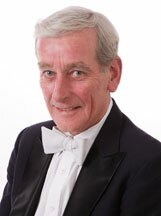Andrew Manze has been better known in Seattle for his mastery of the Baroque violin and his ability to engage and pull in listeners like the Pied Piper, but for some years now he has been moving into conducting and expanding his range to the full classical repertoire.
This week he is here conducting one of the Seattle Symphony’s Masterworks series at Benaroya Hall. While the program included, Thursday night, one Baroque work by Henry Purcell, arranged from various short piece into a Suite by Benjamin Britten and Manze himself, the other two works were Mozart’s Piano Concerto No. 23 in A Major with soloist Simone Dinnerstein, and Vaughan Williams’ Fifth Symphony in D Major.
Anyone expecting a Baroque-style approach to the Purcell and 18th century performance practices applied to the Mozart would have been disappointed.
The Purcell Suite arrangements are for a modern orchestra, though using only Purcell’s notes. The four sections are brief, a couple of them just snatches, so that there is barely time to get into them before they are over. Nevertheless, Manze and the slightly reduced symphony gave a sprightly performance.
The Mozart sounded unabashedly modern. It was composed in 1786, when the piano was in its infancy. Mozart would have used an early fortepiano, a light, agile instrument with brief tone decay, very different from the ponderous, nine-foot Steinway grand piano with the lid full up that Dinnerstein used. She is a remarkable pianist, one who considers and shapes every note, and her and the orchestra’s performance had vigor and excitement, but not the elegance we associate with Mozart. The audience was politely enthusiastic, but overall this was not a moving performance.
What a contrast was the Vaughan Williams!
Manze took a few minutes to put this symphony in the context of its time. It was composed between 1938 and 1943, begun when the clouds of war were gathering all over Europe, and completed and first performed at the Promenade Concerts in London in 1943. London had endured two years of bomb-battering and destruction by then, and one year of some victories accomplished at great price. By 1943, the tide was turning, and England felt it might come out of this terrible war on the winning side — which had not been so clear, despite Churchill’s valiant words, in the early war years.
This symphony, as described to Manze by a 95-year-old who had been at that first performance as a sound engineer, came to the audience like a beacon of hope.
And that’s how Manze conducted this big work, 42 minutes long. The first movement sounds like the rising dawn of a promising day, continuing upwards into a time of peaceful sunniness with the brass contributing to the high warmth of noon, and then gradually dropping gently, but still peaceful, still open and warm, towards dusk and evening’s silence. You can almost hear the birds.
A light and slightly quirky movement follows, quite short, folk-like and upbeat, but still with the serenity engendered by the first, and then a slower, more stately, quite somber movement, with a spiritual, processional feel.
Lastly comes a movement of optimistic determination, a kind of British grit in music, but with a particularly beautiful serene midsection, the sound flowing, the instruments weaving in and out of each others’ melodies.
This is not in any way listed as a war symphony, yet it captures the spirit of the time with a message of better times to come. Manze and the orchestra gave it their all in a profoundly sensitive performance, the orchestra played its heart out and at the end, the audience stayed silent for a long, long moment before the appreciative applause broke out.
This program is repeated Saturday, Oct. 12.
Connect with us on Facebook, Twitter, and Instagram for more like this. And to, you know, be friends.
